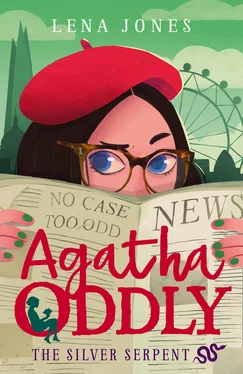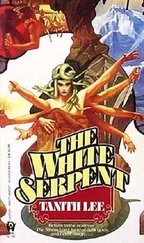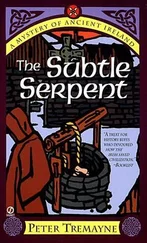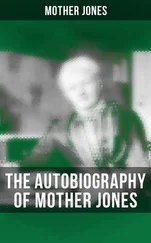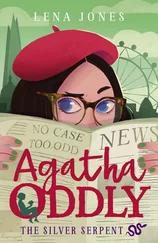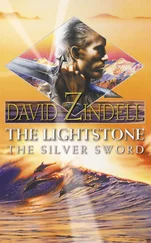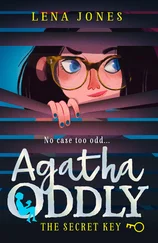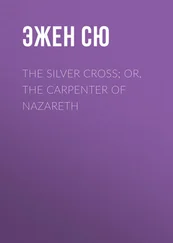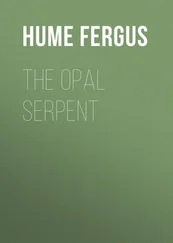I feel myself flush with embarrassment and frustration. What do I have to do to make her trust me? ‘I won’t – I promise,’ I say, biting back the urge to defend myself.

Arthur is waiting for me outside the office. He nods towards the corridor we need to take to the induction room, and we begin walking side by side. As we pass door after door, part of my mind marvels, as always, at the scale of this underground community.
‘So, you’re Clara Oddlow’s daughter?’ he says.
‘How did you know that?’ I ask.
He shrugs. ‘Common knowledge within the Guild.’
‘Oh.’ I take that in. ‘So, what do you know about her?’
‘Well, she’s a bit of a legend around here, isn’t she? Something to live up to. Must be hard for you, as her daughter.’
‘Well, if I let myself think too hard about it, I’d be paralysed with fears of inadequacy and failure!’ I laugh to show I’m not entirely serious.
‘I believe it’s best not to dwell on the negatives,’ says Arthur. ‘Life’s hard enough at times, without setting yourself up to fail.’
‘That’s exactly what I think!’ We smile at each other. ‘What’s the case?’ I ask him. ‘Professor D’Oliveira said you’re an art expert, so I’m guessing it’s about art?’
‘It is indeed,’ said Arthur. ‘Let’s go in here and then I’ll fill you in.’ He opens the door to the induction room. Unlike the previous times I’ve visited this space, now there are a number of other people sitting at tables, mainly sifting through files. We take seats on the far side, near the radiator. The cold wind doesn’t reach these offices, but it’s still distinctly chilly underground.
I glance around. One man is studying something that looks like a photo, but he’s using his phone to examine it.
‘What’s he doing?’ I whisper to Arthur.
‘It’s a special app. The thing he’s examining is a bit like a microfiche – do you know about those?’
I squeeze my eyes shut for a moment as I summon up my mental filing cabinet and flick through the imaginary, hand-written cards until I reach the right one:
‘ A flat piece of film containing microphotographs of the pages of a document ,’ I say, reading the text inside my mind.
‘That’s right – tiny images, which you have to view through a special machine that magnifies them. Well, this is a thing called a nanofiche. It was invented by someone at the Guild and can only be viewed using the organisation’s own app.’
‘Wow, that’s cool.’
He points to another person, a woman apparently staring straight ahead of her. The only thing odd about her – apart from this behaviour – is her glasses, which are larger and more clunky than normal. They remind me of the ones an optician uses to test your eyes.
‘She’s watching an information reel,’ Arthur says.
‘She’s actually watching something?’ I say uncertainly. I’m not sure if he’s teasing me.
‘Yep. Those glasses she’s wearing are another Guild invention – the Spectacular. The lenses are really tiny screens.’
‘Wow,’ I say again. Then I lean forward. ‘So, what’s the case?’ I ask again eagerly.
‘Oh, you’ll like this one,’ he says. ‘It’s about the National Gallery.’
‘Seriously?’
‘I’m always serious about art,’ he says. I look at this boy – with his floppy blond hair and dimples – and can’t imagine he’s ever serious about anything.
He draws a sheet of paper from the folder the professor gave us.
‘This is Dr Elizabeth MacDonald, the director of the National Gallery,’ he says, showing me a newspaper clipping of a woman standing in front of Sunflowers . She’s an elderly lady, in a tweed skirt-suit with loafers and is dwarfed by the large canvas. Her white hair is pinned back in a neat bun. She resembles a kindly nanny from a children’s book far more than the director of one of the most famous art galleries in the world.
‘OK …’ I say, scanning her clothing, her stance and her expression. I don’t believe you can work out much about a person from a photograph – especially a posed one, when they’re on their guard – but a person’s choice of dress says a little about how they want to be seen. And how a person desires to be viewed offers certain hints regarding the way they feel about themselves. Elizabeth MacDonald, I decide, is clearly secure enough in her knowledge and experience of the art world not to feel the need to resort to designer clothing or outrageous dress, in order to make her mark.
He draws another sheet from the file: a square photograph.
‘And this is Sheila Smith, the senior curator.’ The picture shows a woman with wavy blonde hair and bright-red lipstick. He places a one-page document below the image. ‘And this is the report on her disappearance.’
I look up sharply. This is the first time he’s lost his jovial tone and seems genuinely grave. ‘Disappearance?’
‘That’s right. She was reported missing yesterday morning, by Dr MacDonald – although it seems that no one’s seen her since Friday night, when she failed to board a flight.’
I take a moment to process this. ‘How long have you been working on this case then?’
‘I’d only just started when I met you at the Van Gogh yesterday. I’d come straight from a meeting with Dr MacDonald. In fact, I had thought I’d be teamed up with Sofia. Between ourselves, I was quite relieved when she had to fill in for someone who’s off sick. She’s a bit … uptight, if you know what I mean?’
I laugh. ‘So, where was Sheila meant to be going?’
He draws out a notebook from his rear trouser pocket and consults his notes. ‘Colombia,’ he replies, ‘to view a painting that’s just come on the market. The National Gallery’s interested in buying it. It was the art dealer over there, in Bogotá, who called Dr MacDonald on Monday morning, to say Sheila had never arrived.’
‘Has anyone checked if she boarded the plane?’
He nods. ‘Dr MacDonald made enquiries with the airport. It was a late-night flight – eleven o’clock – but Sheila never checked in.’
‘What about her family?’
‘They haven’t heard from her.’
‘Why didn’t someone just call the police?’ I ask. ‘It sounds like a straightforward missing person’s case.’
‘Ah. The police aren’t convinced there’s “foul play” involved. They say Ms Smith is perfectly within her rights to take off without notifying anyone. They did have a quick check of her flat, and there was no sign of a struggle. Also, her passport’s missing, so she could have gone anywhere – by ferry, if not by plane. They said they’re happy to hand it over to a private investigator for now, which is why Dr MacDonald contacted us. There’s an agreement that we must tell the police if we turn up anything serious. And they said they’ll have to intervene if we haven’t found her by Friday evening.’
‘We need to get a move on then,’ I say. ‘What else is in that folder?’
‘Not much – it’s waiting to be filled. Oh – I’m meant to give you this.’ He hands me a fake ID badge, with my name beneath my photo and a company name.
‘Who are Prodigal Investigations?’ I ask.
‘That’s our undercover employer, while we’re working this case. It avoids awkward questions about the Guild. The story goes that we’ve been recruited by a PI agency that specialises in hiring promising young people. It’s just to show to anyone who asks too many questions.’
‘Fair enough,’ I say and stash the badge in the outside pocket of my backpack.
Читать дальше
